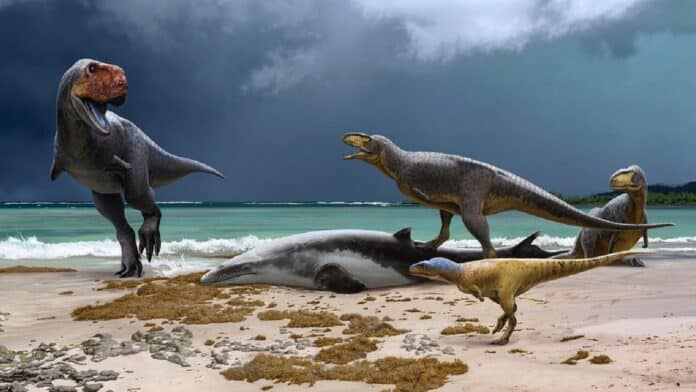In Morocco, Scientists have discovered fossils of primitive cousins of T. rex that had short bulldog snouts and even shorter arms. These two new dinosaur species belong to the Abelisauridae family, which were carnivorous dinosaurs that were counterparts to the tyrannosaurs of the Northern Hemisphere. They lived at the end of the Cretaceous period and showed that dinosaurs were diverse in Africa just before their mass extinction by an asteroid 66 million years ago.
Morocco was home to diverse dinosaur species just before a giant asteroid struck the Cretaceous’s end, ending the dinosaurs’ age. Two new Cretaceous-era dinosaur species have been discovered in Morocco, just outside Casablanca. Both belonged to a family of primitive carnivorous dinosaurs called abelisaurs and lived alongside the much larger Chenanisaurus barbaricus. One species, discovered near the village of Sidi Daoui, is represented by a foot bone from a predator about two and a half meters (eight feet) long. The other is the shin bone of a carnivore that grew to be around five meters (15 feet) long and came from nearby Sidi Chennane.
There are five different species represented by the few dinosaur fossils recovered so far: a duckbill dinosaur called Ajnabia, a titanosaur with a long neck, the giant abelisaur Chenanisaurus, and now two new abelisaurs.
Dr. Nick Longrich from the Milner Centre for Evolution at the University of Bath, who led the study, said, “It’s a shallow, tropical sea full of plesiosaurs, mosasaurs, and sharks. It’s not exactly where you’d expect to find many dinosaurs. But we’re finding them.”
The region is rich in fossils, providing the best picture of African dinosaurs from the end of the age of dinosaurs. Paleontologists often recover fossils from new species, suggesting the beds host an extremely diverse dinosaur fauna.
Dr. Longrich said, “We also have other fossils, but they’re currently under study. So we can’t say much about them now, except that this was an amazingly diverse dinosaur fauna.”
The last dinosaurs vanished around 66 million years ago, along with up to 90% of all species on the earth, including mosasaurs, plesiosaurs, pterosaurs, and ammonites. More than two hundred years have passed since scientists debated the extinction pattern and its causes at the end of the Cretaceous.
The researcher said, “It also grew colder near the end, so it might not be surprising if dinosaurs at higher latitudes became less diverse. But we don’t know much about dinosaurs from lower latitudes.”
Moroccan dinosaurs thrived in North Africa till the end. The end of the Cretaceous in western North America appears less diversified. However, it’s unclear whether this is true globally. Dinosaur remains in Morocco convey the same messages as numerous marine reptile remains, showing that biodiversity was not declining but relatively diversified.
Nour-Eddine Jalil, a professor at the Natural History Museum and a researcher at Universite Cadi Ayyad in Morocco, who was a co-author on the paper, said, “When T. rex reigned as a mega predator in North America, abelisaurs sat at the top of the food chains in North Africa.”
Journal Reference:
- Nicholas R. Longrich, Erik Isasmendi, et al. New fossils of Abelisauridae (Dinosauria: Theropoda) from the upper Maastrichtian of Morocco, North Africa. Cretaceous Research. DOI: 10.1016/j.cretres.2023.105677
